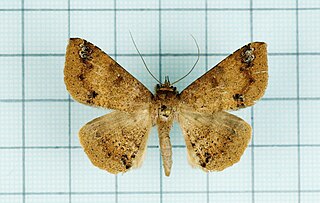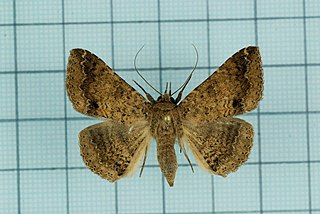
The Zygaenidae moths are a family of Lepidoptera. The majority of zygaenids are tropical, but they are nevertheless quite well represented in temperate regions. Some of the 1000 or so species are commonly known as burnet or forester moths, often qualified by the number of spots, although other families also have 'foresters'. They are also sometimes called smoky moths.

The Calpinae are a subfamily of moths in the family Erebidae described by Jean Baptiste Boisduval in 1840. This subfamily includes many species of moths that have a pointed and barbed proboscis adapted to piercing the skins of fruit to feed on juice, and in the case of the several Calyptra species of vampire moths, to piercing the skins of mammals to feed on blood. The subfamily contains some large moths with wingspans longer than 5 cm (2 in).
The inland forest bat is a vespertilionid bat that occurs in central and arid regions in Australia. They were first described in 1987, published in a review of poorly surveyed microbat populations. A tiny flying mammal, whose body is around twelve millimetres (½ inch) long, that occupies small cavities in trees and buildings while roosting. The nocturnal activity is foraging for insects, typically moths.

Ericeia is a genus of moths in the family Erebidae. The genus was erected by Francis Walker in 1858.

Abantiades latipennis, known as the Pindi moth, is a species of moth in the family Hepialidae. It may also be referred to as a swift moth or a ghost moth, as this is a common name associated with Hepialidae. Endemic to Australia and identified in 1932, it is most populous in temperate rainforest where eucalypti are prevalent, as the larvae feed primarily on the roots of these trees. Females lay eggs during flight in a scattering fashion. The larvae live for over eighteen months underground, while adult moths survive for approximately one week, as they have no mouthparts with which to feed. The moths are preyed upon by a number of predators, including bats and owls. Brown in colour overall, males are paler and the identifying silver bars of the male's wings are more prominent than those of the female's, with dark margins. Male adults are generally smaller.

Ericeia subsignata is a moth of the family Erebidae. It is known from Australia, including the Australian Capital Territory.

Ericeia inangulata, the sober tabby, is a moth in the family Erebidae. The species was first described by Achille Guenée in 1852. It is found in the Indo-Australian tropics of China, India, Sri Lanka, Myanmar, and the Marianas and Carolines, Fiji, Vanuatu, New Caledonia and Samoa.

Ericeia pertendens is a moth in the family Erebidae first described by Francis Walker in 1858. It is found from the Indo-Australian tropics to the Solomon Islands.

Ericeia lituraria is a moth in the family Erebidae. It is found in central and southern Africa and on the islands of the Indian Ocean.
The Hulodini are a tribe of moths in the family Erebidae.
Ericeia sobria is a moth in the family Erebidae. It is found in Kenya, South Africa, Gambia, Borneo, New Guinea and Australia, where it has been recorded from Queensland and New South Wales.
Ericeia congregata is a moth in the family Erebidae. It is found in Angola, Cameroon, Cape Verde, the Comoros, the Democratic Republic of Congo, Gabon, Kenya, La Réunion, Madagascar, Mauritania, Mauritius, Sierra Leone, South Africa, Gambia, Uganda, Yemen, Saudi Arabia, India and Sri Lanka.

Ericeia amanda is a moth in the family Erebidae. It is found on Borneo, Sumatra and Peninsular Malaysia. The original description notes Adelaide, Australia as type locality, but the species is not known from Australia.
Ericeia korintjiensis is a moth in the family Erebidae. It is found on Sumatra, Java and Borneo. The habitat consists of forested areas up to altitudes of about 1,790 meters.

Ericeia eriophora is a moth in the family Erebidae. It is found from the Oriental tropics to the Philippines and Sulawesi.
Ericeia brunnescens is a moth in the family Erebidae. It is found on Borneo, Sumatra and Java.
Ericeia goniosema is a moth in the family Erebidae. It is found in New Guinea and Australia, where it has been recorded from Queensland.
Ericeia hirsutitarsus is a moth in the family Erebidae. It is found on Norfolk Island, New Caledonia, Vanuatu, the New Hebrides and the Loyalty Islands.
Ericeia leichardtii is a moth in the family Erebidae. It is found on Fiji, Tonga, the Loyalty Islands Samoa and in northern Australia.
Ericeia plaesiodes is a moth in the family Erebidae. It is found in Australia, where it has been recorded from Queensland, the Northern Territory and New South Wales.








